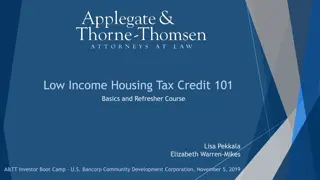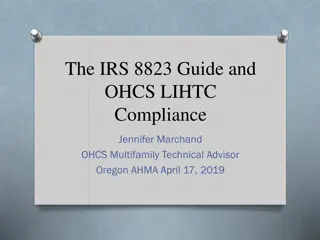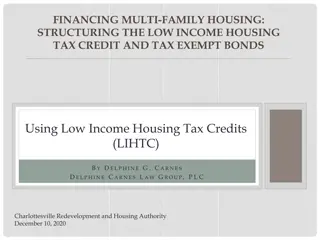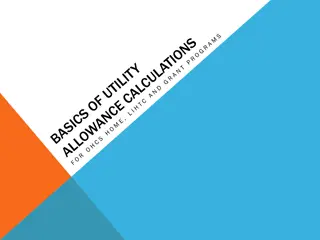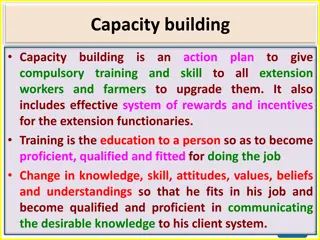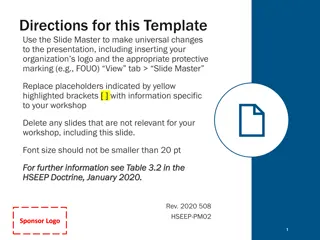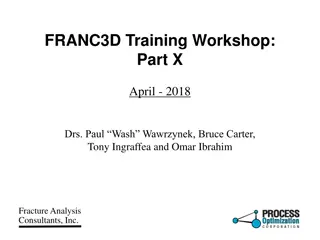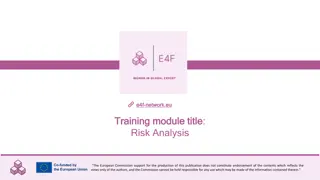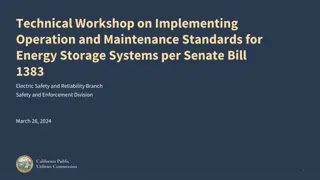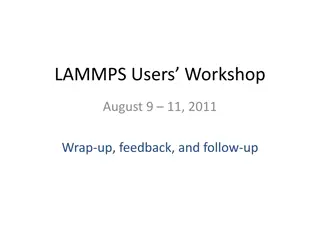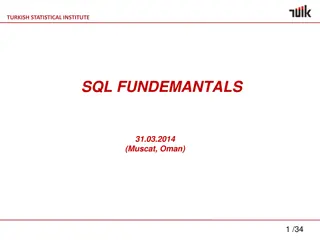LIHTC Development Fundamentals Training Workshop Overview
This workshop covers the key aspects of the Low-Income Housing Tax Credit (LIHTC) program, including an overview of the development process, understanding 4% and 9% credits, basis and credit calculation, financing a sample project, qualified allocation plan (QAP), evaluating projects, subsequent awards, compliance, and more. It delves into pre-development activities, application processes, financing steps, and project finalization requirements.
Download Presentation

Please find below an Image/Link to download the presentation.
The content on the website is provided AS IS for your information and personal use only. It may not be sold, licensed, or shared on other websites without obtaining consent from the author. Download presentation by click this link. If you encounter any issues during the download, it is possible that the publisher has removed the file from their server.
E N D
Presentation Transcript
LIHTC Development Fundamentals Training Workshop October 21, 2021 1 1 Overview of Development Process & Low Overview of Development Process & Low- -Income Housing Tax Credit Program Income Housing Tax Credit Program 2 2 Understanding 4% and 9% Credits Understanding 4% and 9% Credits 3 3 Basis and Credit Calculation Basis and Credit Calculation 4 4 Financing a Sample Project Financing a Sample Project 5 5 Qualified Allocation Plan (QAP) Qualified Allocation Plan (QAP) 6 6 Evaluating Projects, Subsequent Awards, and Compliance Evaluating Projects, Subsequent Awards, and Compliance 7 7 Questions Questions
LIHTC Development Fundamentals Training Workshop October 21, 2021 1 1 Overview of Development Process & Low Overview of Development Process & Low- -Income Housing Tax Credit Program Income Housing Tax Credit Program 2 2 Understanding 4% and 9% Credits Understanding 4% and 9% Credits 3 3 Basis and Credit Calculation Basis and Credit Calculation 4 4 Financing a Sample Project Financing a Sample Project 5 5 Qualified Allocation Plan (QAP) Qualified Allocation Plan (QAP) 6 6 Evaluating Projects, Subsequent Awards, and Compliance Evaluating Projects, Subsequent Awards, and Compliance 7 7 Questions Questions
Development Process 1. Pre-Pre-Development Development team selection: Developer, Project Owner, General Partner, contractor, management company, consultant(s), architect, attorney, accountant, service provider, etc. Memorandums of Understanding or other agreements drafted Pre-Development Market analysis and feasibility studies Land acquisition or securing option rights to purchase land Environmental assessments Surveys Site plans, development plans, and building plans Permitting Permanent and Construction Financing LOIs Additional funding sources secured 2. 3
Development Process 3. Application for tax credits and/or other MFA financing resources MFA takes 4% applications and other MFA financing on a rolling basis, but 9% applications are due at the end of January (and can include applications for other MFA financing at that time) Continued Pre-Development following an award Finalize construction financing and other financing Rezoning process (agricultural land and non-zoned land only) Finalize Construction Drawings Identify contractor (if this has yet to happen) and sign construction contract Permitting Some infrastructure improvements 4. 4
Development Process 5. Construction MFA must approve construction documents and contracts ahead of construction start MFA will monitor construction progress with on-site inspections at the 33% and 66% points, as well as at the close of construction Tax credit projects usually have a required 2-year (or 24- month) period for construction MFA requires a meeting with MFA s Housing Development and Asset Management staff, the developer, and the on-site management staff for the project around the 50% mark of construction Operation Project must lease units to eligible tenants in order to consider them Placed in Service A Land Use Restriction Agreement (LURA) must be recorded with the property 6. 5
Development Process Other issues that may arise: Appeals from neighbors or other interested parties Disputes between the developer and the jurisdiction An involved design process that requires multiple site plan iterations 6
Low-Income Housing Tax Credits Internal Revenue Service program created by Tax Reform Act of 1986 to provide alternative funding for low- and moderate-income households Program is administered by the US Treasury Department Credits are allocated by a designated Housing Credit Agency through a Qualified Allocation Plan (QAP) Credit is a dollar for dollar tax reduction for 10 years Credit amount is based on the cost of acquiring, constructing or rehabilitating housing developments Investors purchase credits to offset federal tax liability Equity from the sale of credits reduces debt, resulting in lower rents 7
Low-Income Housing Tax Credits Internal Revenue Service program created by Tax Reform Act of 1986 to provide alternative funding for low- and moderate-income households In New Mexico, LIHTC Program is administered by New Mexico Mortgage Finance Agency (MFA) Both 9% and 4% credits available 4% credits are as of right with the use of tax exempt bonds 9% credits are competitive For 9% LIHTC, states receive a finite allocation of tax credits each year, allocated on a per capita basis (approx. $5-6M per year in NM) 8
Low-Income Housing Tax Credits Calculated based on the production of rental units serving residents earning no more than 80% of area median income (AMI), with a focus on those earning no more than 60% of AMI Projects must continue to serve low-income residents for a minimum of 30 years Investors also derive tax benefits from losses Credits may be recaptured by the IRS if the project does not comply in the first 15 years (Compliance Period) 9
Low-Income Housing Tax Credits Process Investors Internal Revenue Service Low-Income Rental Development Housing Credit Allocating Agency Limited Partnership 10
Low-Income Housing Tax Credit Process Tax credits are allocated to the designated Allocation Agency on a per-capita basis $5.9 million allocated to NM in 2021 Allocation Allocation Ex. Project A: $1,000,000 in credits awarded. Credits are awarded to proposed development projects through a competitive process, outlined by the Qualified Allocation Plan. Awards Awards Ex. Project A: Projects sell 10-years worth of credits to investor looking to off-set tax liability (around 88 cents per dollar of credit), producing around 70% of the total development costs. $1,000,000 x 10 years = Equity Produced Equity Produced $10,000,000 in total credits While the investor takes credits annually for only the first 10 years, credits can be recaptured if the project is not in compliance for 15 years. Additional, extended compliance periods range from 15-20 more years, following the initial 15 years. $10,000,000 x $0.88 = Compliance Compliance $8,800,000 in equity produced 11
Affordable versus Market Rate Development Somewhat comparable hard construction costs although market rate projects have more flexibility in construction scope. Affordable deals have additional soft costs (i.e. developer fee, legal and accounting fees, certain financing costs and project reserves) due to regulatory and compliance requirements. Market rate: structured to generate cash flow as rents increase and property appreciation generates gain at disposition. Affordable: restricted rents and market result in limited or no cash flow and long-term affordability restricts upside at disposition 12
Limited Partner Structure General Partner (GP) owns just 0.01% but controls and operates the project; Passive limited partner (LP) invests equity in return for 99.99% ownership; Sale to investor LP of most of Credits and tax losses maximizes investor equity; More investor equity reduces other financing needs. 13
Limited Partner Structure Vista Villa Valley Apartments General Partnership General Partner (0.01%) Limited Partner Investor (99.99%) 14
Team Members Development Team Developer General Contractor Architect Attorney Accountant Property Manager Consultant(s) Lenders Construction lender Permanent lender(s) Lender attorneys Syndicator Underwriter Fund Manager Attorney State HFA (MFA) 15
Investor Risks and Benefits Market Risk: ability to effectively assess market for development and remain competitive in the market throughout the affordability period. Construction and lease-up risk: units must be completed and rented to specified residents to claim Credits. Tax risk: recapture of Credits taken in prior tax years and ability to claim future Credits due to project noncompliance. Tax benefits: 10-year stream of tax credits + depreciation and losses. Social benefits: social responsibility Other benefits: portfolio diversification 16
Development Requirements Minimum percentage of LIHTC units (20/50, 40/60, or Average Income). Maximum rents limited for LIHTC units. Minimum 30-year affordability commitment per Code Credits cannot exceed amount necessary for financial feasibility Developments must satisfy state QAP Market study required Projects subject to IRS and state regulation oversight 17
Affordability Commitment 30 year Affordability Commitment per Code 15-year Compliance Period At least 15-year Extended Use Period Land Use Restriction Agreement (LURA) - extended use agreement Early termination of 30-year affordability commitment: Foreclosure Qualified Contract (not an option in NM) 18
Income and Rent Restrictions Minimum Set-Aside election of: 20% of units at 50% of area median gross income (AGMI or AMI), or 40% of units at 60% of AMI Average of the low-income units at or below 60%, but units can serve up to 80% Must meet minimum set aside by end of first Credit year. Gross rent cannot exceed 30% of qualifying income for an assumed family size (based on number of bedrooms). Income/rent limits change annually; HUD publishes income and rent limits (posted on MFA website). Gross rent must include an allowance for tenant paid utilities. Gross rent does not include Section 8 or similar subsidy. 19
Income and Rent Restrictions Area Median Income = $67,500 (ABQ, 2021) 2 bedroom unit: assumed family size of 3 persons (2 bedrooms x 1.5 persons per bedroom) 60% of Area Median Income: 3 person income limit = $36,480 30% of income limit = $10,944 Monthly gross rent (1/12) = $912 20
Q: In contrast to market rate properties, affordable housing developer/owners a) can generate income from the property s cash flow for the long term; b) take a large up-front fee to cover costs; c) both a) and b) 21
Q: In contrast to market rate properties, affordable housing developer/owners a) can generate income from the property s cash flow for the long term; b) take a large up-front fee to cover costs; c) both a) and b) 22
LIHTC Development Fundamentals Training Workshop October 21, 2021 1 1 Overview of Development Process & Low Overview of Development Process & Low- -Income Housing Tax Credit Program Income Housing Tax Credit Program 2 2 Understanding 4% and 9% Credits Understanding 4% and 9% Credits 3 3 Basis and Credit Calculation Basis and Credit Calculation 4 4 Financing a Sample Project Financing a Sample Project 5 5 Qualified Allocation Plan (QAP) Qualified Allocation Plan (QAP) 6 6 Evaluating Projects, Subsequent Awards, and Compliance Evaluating Projects, Subsequent Awards, and Compliance 7 7 Questions Questions
Low-Income Housing Tax Credits Rates 9% Credits: 70% present value Subject to MFA s Credit ceiling and competitive tax credit round Used for new construction and substantial rehab if building is not federally subsidized (which means financed by tax-exempt bonds) Credit rate is not less than 9% per PATH Act of 2015 24
Low-Income Housing Tax Credits Rates 4% Credits: 30% present value Applies to acquisition costs of a building As of right for new construction or rehab projects using tax exempt bond financing Subject to award of private activity bond volume cap from NM State Board of Finance Credit rate is not less than 4% per the Consolidated Appropriations Act, 2021 25
Low-Income Housing Tax Credits Rates Acquisition/ Rehabilitation New Construction Not Federally Subsidized (not using volume-cap bond 9% 4%/9% debt) Federally Subsidized volume-cap bond debt 4% 4%/4% 26
Tax-Exempt Bonds and 4% Credits Projects financed (whether new construction or rehab) with volume cap bonds are eligible for 4% credits only. Not subject to MFA s rigorous tax credit round but still must follow QAP and application requirements. Rolling applications. Not subject to carryover allocation and 10% test requirements. 50% test: bond amount must exceed 50% of depreciable basis plus land. 27
Tax-Exempt Bonds and 4% Credits Bond deals are subject to additional rules regarding the tax- exempt status of the bonds: Requires allocation of State private activity bond volume cap. Public hearing or TEFRA requirement- must conduct a public hearing and provide notice by publishing 14 days prior to the hearing. Inducement Resolution and Bond Resolution Costs of issuance limitation Good costs vs. bad costs 28
4% Acquisition Credits The 4% acquisition credit is used when an owner purchases an existing building that qualifies as a substantial rehab and satisfies the 10 year rule (if applicable). Basis boost is not available for acquisition credits (more later on boost) Computing acquisition basis- cost of building including acquisition-related costs If not 100% low income, only low income percentage of cost can qualify 29
Q: True or false, 9% credits can be used for new construction projects OR acquisition or rehabilitation project costs? A: FALSE (only 4% credits can be used for acquisition project costs) 30
Q: True or false, 9% credits can be used for new construction projects OR acquisition or rehabilitation project costs? A: FALSE (only 4% credits can be used for acquisition project costs) 31
LIHTC Development Fundamentals Training Workshop October 21, 2021 1 1 Overview of Development Process & Low Overview of Development Process & Low- -Income Housing Tax Credit Program Income Housing Tax Credit Program 2 2 Understanding 4% and 9% Credits Understanding 4% and 9% Credits 3 3 Basis and Credit Calculation Basis and Credit Calculation 4 4 Financing a Sample Project Financing a Sample Project 5 5 Qualified Allocation Plan (QAP) Qualified Allocation Plan (QAP) 6 6 Evaluating Projects, Subsequent Awards, and Compliance Evaluating Projects, Subsequent Awards, and Compliance 7 7 Questions Questions
Low-Income Housing Tax Credits Basis Non-eligible basis costs Land Off-site work Interest payable on permanent loans Insurance and property tax expenses incurred following construction completion Application fees Origination/discount points Title fees Legal fees Reserves Syndication fees Federal grants Post-construction working capital Eligible basis costs Construction costs on-site Professional fees Construction period financing fees Developer and consultant fees 33
Low-Income Housing Tax Credits Boost 30% increase ( boost ) to eligible basis for new construction and rehabilitation costs only (acquisition costs not eligible). HUD designated QCT, DDA or SADDA OR those that serve a target population and have a need for financial feasibility Not Federally Subsidized (not using volume-cap bond debt) Federally Subsidized volume-cap bond debt HUD designated QCT, DDA or SADDA 34
Qualified Basis Qualified Basis: Adjusted Eligible Basis for non-income qualified resident using Applicable Fraction , which is the lesser of: The number of qualifying rent-paying residential units over the total number of rent-paying residential units, OR The square footage of qualifying rent-paying residential units over the total square footage of rent-paying residential units 35
Low-Income Housing Tax Credits Example New Construction Credit by Basis Eligible Basis Exclusions* Eligible Basis QCT/DDA Boost Adjusted Basis App Fraction Qualified Basis Applicable % Annual Credit $10,000,000 $10,000,000 130.0000% $13,000,000 100% $13,000,000 9.00% $1,170,000 $11,700,000 99.99% $11,698,830 x 10 years Investor Portion Price per Credit Credit Proceeds $0.88 $10,294,970 36
Low-Income Housing Tax Credits Example New Construction Credit by Basis 1. What is the Tax Credit Award amount? Eligible Basis Exclusions* Eligible Basis QCT/DDA Boost Adjusted Basis App Fraction Qualified Basis Applicable % Annual Credit $10,000,000 $10,000,000 130.0000% $13,000,000 100% 2. What is the Equity generated for the project? $13,000,000 9.00% $1,170,000 $11,700,000 99.99% $11,698,830 x 10 years Investor Portion Price per Credit Credit Proceeds $0.88 $10,294,970 37
Low-Income Housing Tax Credits Example New Construction Credit by Basis Eligible Basis Exclusions* Eligible Basis QCT/DDA Boost Adjusted Basis App Fraction Qualified Basis Applicable % Annual Credit $10,000,000 $10,000,000 130.0000% $13,000,000 100% $13,000,000 9.00% $1,170,000 $11,700,000 99.99% $11,698,830 Award x 10 years Investor Portion Price per Credit Credit Proceeds $0.88 $10,294,970 Equity 38
LIHTC Development Fundamentals Training Workshop October 21, 2021 1 1 Overview of Development Process & Low Overview of Development Process & Low- -Income Housing Tax Credit Program Income Housing Tax Credit Program 2 2 Understanding Understanding 4 4% and % and 9 9% Credits % Credits 3 3 Basis and Credit Calculation Basis and Credit Calculation 4 4 Financing a Sample Project Financing a Sample Project 5 5 Qualified Allocation Plan (QAP) Qualified Allocation Plan (QAP) 6 6 Evaluating Projects, Subsequent Awards, and Compliance Evaluating Projects, Subsequent Awards, and Compliance 7 7 Questions Questions
Low-Income Housing Tax Credits Example Acquisition / Rehabilitation Acquisition Credit by Basis Eligible Basis Exclusions* Eligible Basis QCT/DDA Boost Adjusted Basis App Fraction Qualified Basis Applicable % Annual Credit x 10 years Investor Portion Rehabilitation Credit by Basis Eligible Basis Exclusions* Eligible Basis QCT/DDA Boost Adjusted Basis App Fraction Qualified Basis Applicable % Annual Credit x 10 years Investor Portion $2,000,000 $10,000,000 $2,000,000 100.0000% $2,000,000 100% $2,000,000 4.00% $80,000 $800,000 99.99% $799,920 $10,000,000 130.0000% $13,000,000 100% $13,000,000 9.00% $1,170,000 $11,700,000 99.99% $11,698,830 Price per Credit Credit Proceeds $0.88 Price per Credit Credit Proceeds $0.88 $703,930 $10,294,970 Combined Annual Credit (Award): $1,250,000 Combined Credit Proceeds (Equity): $10,998,900 40
Maximum Debt Supportable 100 unit project Gross Potential Income Less: Vacancy (7%) Effective Gross Income Less: Expenses per unit per annum (pupa) Less: Replacement Reserves pupa Net Operating Income Divide by Required Debt Coverage Ratio (1.20) Divide by Debt Constant (0.0645; 5.0% interest, 30 year amortization) $900,000 ($63,000) $837,000 ($470,000) ($30,000) $337,000 $280,833 $4,354,000 41
Gap Estimation 100 unit project Total Development Costs Less: Tax Credit Equity $16,000,000 ($10,998,900) $5,001,100 ($4,354,000) $647,100 Less: Estimated First Mortgage Gap 42
Gap Financing Government Sources: Project/Developer Sources: Soft Mortgage Debt Deferred Developer Fee HOME Reduce Acquisition Cost CDBG General Partner Loan or Equity National Housing Trust Fund Private Sources: Better 1st mortgage terms FHLB Affordable Housing Program 43
2020 LIHTC Gap Funding Program Type Contact Information 542(c)Risk Share Construction/ Permanent Tim Martinez tmartinez@housingnm.org HOME Construction/ Permanent Jacobo Martinez jmartinez@housingnm.org HOME-CHDO Set-Aside Construction/ Permanent Jacobo Martinez jmartinez@housingnm.org National Housing Trust Fund (NHTF) Construction/ Permanent Jacobo Martinez jmartinez@housingnm.org NM Housing Trust Fund (NMHTF) Construction/ Permanent Tim Martinez tmartinez@housingnm.org Primero Loans Predevelopment/ Construction Sharlynn Rosales srosales@housingnm.org 44
Q: What is the required debt service coverage ratio that MFA underwrites to? a) 1.20 b) 1.10 c) 1.15 A: FALSE (only 4% credits can be used for 45
Q: What is the required debt service coverage ratio that MFA underwrites to? a) 1.20 b) 1.10 c) 1.15 A: FALSE (only 4% credits can be used for 46
LIHTC Development Fundamentals Training Workshop October 21, 2021 1 1 Overview of Development Process & Low Overview of Development Process & Low- -Income Housing Tax Credit Program Income Housing Tax Credit Program 2 2 Understanding 4% and 9% Credits Understanding 4% and 9% Credits 3 3 Basis and Credit Calculation Basis and Credit Calculation 4 4 Financing a Sample Project Financing a Sample Project 5 5 Qualified Allocation Plan (QAP) Qualified Allocation Plan (QAP) 6 6 Evaluating Projects, Subsequent Awards, and Compliance Evaluating Projects, Subsequent Awards, and Compliance 7 7 Questions Questions
Qualified Allocation Plan Development Gather input and notes all year, hold focus groups Start in earnest once awards announced (May) One-year cycle Internal approval, then published draft and public comment period (September) Board approval, final draft published (October) Sent to Governor for final approval (November) 48
Qualified Allocation Plan The Code sets forth minimum criteria for inclusion in QAP: project location housing needs characteristics project characteristics, including whether the project includes the use of existing housing as part of a community revitalization plan sponsor characteristics tenant populations with special housing needs public housing waiting lists tenant populations of individuals with children projects intended for eventual tenant ownership the energy efficiency of the project the historic nature of the project 49
Code Requirements Housing Credit Agencies (HCA) must make tax credit allocations pursuant to a QAP that Defines Project Selection Criteria; Gives preference to Projects serving the neediest tenants, for the longest time period, in a QCT with a concerted community revitalization plan; and Defines procedures for compliance monitoring. Code includes the above minimum criteria and grants the HCA broad discretion beyond that. The QAP is to reflect the HCA s housing priorities. 50


